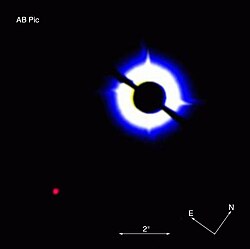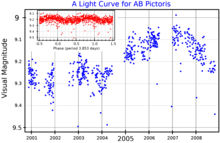AB Pictoris
 Coronagraphic image of AB Pictoris showing its tiny companion (bottom left). The data was obtained on 16 March 2003 with NACO on the VLT, using a 1.4 arcsec occulting mask on top of AB Pictoris. | |
| Observation data Epoch J2000.0 Equinox J2000.0 | |
|---|---|
| Constellation | Pictor |
| Right ascension | 06h 19m 12.913s[1] |
| Declination | −58° 03′ 15.53″[1] |
| Apparent magnitude (V) | 9.13[2] (9.21 to 9.35)[3] |
| Characteristics | |
| Spectral type | K1V(e)[2] |
| B−V color index | 0.861±0.027[4] |
| Variable type | BY Dra[3] |
| Astrometry | |
| Radial velocity (Rv) | 22.6±0.3[2] km/s |
| Proper motion (μ) | RA: 14.314±0.015 mas/yr[1] Dec.: 45.234±0.017 mas/yr[1] |
| Parallax (π) | 19.9452 ± 0.0124 mas[1] |
| Distance | 163.5 ± 0.1 ly (50.14 ± 0.03 pc) |
| Absolute magnitude (MV) | 5.82[4] |
| Details | |
| Mass | 0.90±0.10[5] M☉ |
| Radius | 0.92±0.03[6] R☉ |
| Luminosity | 0.51[4] L☉ |
| Surface gravity (log g) | 4.67±0.09[5] cgs |
| Temperature | 5,188±50[6] K |
| Metallicity [Fe/H] | −0.54[4] dex |
| Rotation | 3.90±0.08 d[7] |
| Rotational velocity (v sin i) | 10.87±0.08[7] km/s |
| Age | 30–40[8] Myr |
| Other designations | |
| Database references | |
| SIMBAD | data |
AB Pictoris (abbreviated AB Pic, also catalogued as HD 44627) is a K-type main-sequence star, located 163.5 light-years away in the southern constellation of Pictor.[1] It has been identified as a member of the young (30 million years old) Tucana–Horologium association.[10] The star has been classified as a BY Draconis variable,[3] indicating it has an active chromosphere. It is an X-ray source and displays emission lines in its spectrum.[11][2]
In 2005 it was announced that an astronomical object (AB Pictoris b, abbreviated AB Pic b) had been imaged in 2003 and 2004 close to and apparently in orbit around the star. Its mass suggests that it is at the borderline between being a brown dwarf or a planet.[12]

Planetary system
[edit]In 2003 and 2004, an object (now catalogued as AB Pictoris b) was observed close to the star by a team of astronomers at the European Southern Observatory. Since it had common proper motion with AB Pictoris, it was concluded that it was physically close to the star. Its spectral type was estimated as between L0V and L3V. Using evolutionary models, its mass was estimated as from 13 to 14 Jupiter masses.[12] However, because modelling such young objects is difficult, this estimate is very uncertain; some models give masses as low as 11 Jupiter masses or as high as 70 Jupiter masses. Temperature estimates range from 1600 K to 2400 K.[8] As it is not known if the mass of the object exceeds the deuterium burning limit of 13 Jupiter masses, it is not clear whether the object should be classified as an extrasolar planet or a brown dwarf.[12] In 2010 a team obtained the spectrum of AB Pic b with VLT/SINFONI. This confirmed this object as an L-dwarf with low surface gravity, matching a spectral type of L0-L1. It also constrained the temperature to 2000+100
−300 Kelvin.[14] Another team found that AB Pic b has a lower temperature of 1400-1700 K and possibly a lower mass (7-14 MJ, from figure 13).[15] A later analysis did find a temperature of 1800+100
−200 K and a mass of 10-14 MJ.[16] The planet shows several molecular and atomic absorption lines in the spectrum. The most notable are water vapor, carbon monoxide, potassium and sodium. The planetary orbit is significantly misaligned with its spin axis orientation (obliquity), possibly due to gravitational interactions with the additional inner planet.[17]
| Companion (in order from star) |
Mass | Semimajor axis (AU) |
Orbital period (days) |
Eccentricity | Inclination | Radius |
|---|---|---|---|---|---|---|
| b | 10±1 MJ | 190+200 −50 |
— | — | 90±12° | 1.8±0.2 RJ |
| c (suspected[17]) | 6 MJ | 6±4 | — | — | — | — |
See also
[edit]References
[edit]- ^ a b c d e Vallenari, A.; et al. (Gaia collaboration) (2023). "Gaia Data Release 3. Summary of the content and survey properties". Astronomy and Astrophysics. 674: A1. arXiv:2208.00211. Bibcode:2023A&A...674A...1G. doi:10.1051/0004-6361/202243940. S2CID 244398875. Gaia DR3 record for this source at VizieR.
- ^ a b c d Torres, C. A. O.; et al. (September 12, 2006). "Search for associations containing young stars (SACY)". Astronomy & Astrophysics. 460 (3): 695–708. arXiv:astro-ph/0609258. Bibcode:2006A&A...460..695T. doi:10.1051/0004-6361:20065602. eISSN 1432-0746. ISSN 0004-6361.
- ^ a b c Samus', N. N; et al. (2017). "General catalogue of variable stars". Astronomy Reports. GCVS 5.1. 61 (1): 80. Bibcode:2017ARep...61...80S. doi:10.1134/S1063772917010085. S2CID 125853869.
- ^ a b c d Anderson, E.; Francis, Ch. (2012). "XHIP: An extended hipparcos compilation". Astronomy Letters. 38 (5): 331. arXiv:1108.4971. Bibcode:2012AstL...38..331A. doi:10.1134/S1063773712050015. S2CID 119257644.
- ^ a b Ghezzi, L.; Cunha, K.; Smith, V. V.; de Araújo, F. X.; Schuler, S. C.; de la Reza, R. (August 19, 2010). "Stellar Parameters and Metallicities of Stars Hosting Jovian and Neptunian Mass Planets: A Possible Dependence of Planetary Mass on Metallicity". The Astrophysical Journal. 720 (2): 1290–1302. arXiv:1007.2681. Bibcode:2010ApJ...720.1290G. doi:10.1088/0004-637X/720/2/1290. eISSN 1538-4357. ISSN 0004-637X.
- ^ a b van Belle, Gerard T.; von Braun, Kaspar (2009). "Directly Determined Linear Radii and Effective Temperatures of Exoplanet Host Stars". The Astrophysical Journal. 694 (2): 1085–1098. arXiv:0901.1206. Bibcode:2009ApJ...694.1085V. doi:10.1088/0004-637X/694/2/1085. S2CID 18370219.
- ^ a b Bowler, Brendan P.; et al. (April 2023). "Rotation Periods, Inclinations, and Obliquities of Cool Stars Hosting Directly Imaged Substellar Companions: Spin-Orbit Misalignments Are Common". The Astronomical Journal. 165 (4): 164. arXiv:2301.04692. Bibcode:2023AJ....165..164B. doi:10.3847/1538-3881/acbd34. 164.
- ^ a b Homogeneous comparison of directly detected planet candidates: GQ Lup, 2M1207, AB Pic, Ralph Neuhaeuser, ESO Workshop Proceedings on Multiple Stars, Bibcode:2005astro.ph..9906N, arXiv:astro-ph/0509906.
- ^ "V* AB Pic". SIMBAD. Centre de données astronomiques de Strasbourg. Retrieved October 3, 2008.
- ^ Inseok Song, B. Zuckerman; Bessell, M. S. (December 2003). "New Members of the TW Hydrae Association, β Pictoris Moving Group, and Tucana/Horologium Association". The Astrophysical Journal. 599 (1): 342–350. Bibcode:2003ApJ...599..342S. doi:10.1086/379194. S2CID 51833191..
- ^ Haakonsen, Christian Bernt; Rutledge, Robert E. (September 2009). "XID II: Statistical Cross-Association of ROSAT Bright Source Catalog X-ray Sources with 2MASS Point Source Catalog Near-Infrared Sources". The Astrophysical Journal Supplement. 184 (1): 138–151. arXiv:0910.3229. Bibcode:2009ApJS..184..138H. doi:10.1088/0067-0049/184/1/138. S2CID 119267456.
- ^ a b c A companion to AB Pic at the planet/brown dwarf boundary, G. Chauvin, A.-M. Lagrange, B. Zuckerman, C. Dumas, D. Mouillet, I. Song, J.-L. Beuzit, P. Lowrance, and M. S. Bessell, Astronomy and Astrophysics 438, #3 (August 2005), pp. L29–L32, Bibcode:2005A&A...438L..29C, doi:10.1051/0004-6361:200500111, arXiv:astro-ph/0504658.
- ^ Kiraga, M. (March 2012). "ASAS Photometry of ROSAT Sources. I. Periodic Variable Stars Coincident with Bright Sources from the ROSAT All Sky Survey". Acta Astronomica. 62 (1): 67–95. arXiv:1204.3825. Bibcode:2012AcA....62...67K. Retrieved 20 February 2022.
- ^ Bonnefoy, M.; Chauvin, G.; Rojo, P.; Allard, F.; Lagrange, A. -M.; Homeier, D.; Dumas, C.; Beuzit, J. -L. (2010-03-01). "Near-infrared integral-field spectra of the planet/brown dwarf companion AB Pictoris b". Astronomy and Astrophysics. 512: A52. arXiv:1001.0470. Bibcode:2010A&A...512A..52B. doi:10.1051/0004-6361/200912688. ISSN 0004-6361.
- ^ Patience, J.; King, R. R.; De Rosa, R. J.; Vigan, A.; Witte, S.; Rice, E.; Helling, Ch.; Hauschildt, P. (2012-04-01). "Spectroscopy across the brown dwarf/planetary mass boundary. I. Near-infrared JHK spectra". Astronomy and Astrophysics. 540: A85. arXiv:1201.3921. Bibcode:2012A&A...540A..85P. doi:10.1051/0004-6361/201118058. ISSN 0004-6361.
- ^ Bonnefoy, M.; Chauvin, G.; Lagrange, A. -M.; Rojo, P.; Allard, F.; Pinte, C.; Dumas, C.; Homeier, D. (2014-02-01). "A library of near-infrared integral field spectra of young M-L dwarfs". Astronomy and Astrophysics. 562: A127. arXiv:1306.3709. Bibcode:2014A&A...562A.127B. doi:10.1051/0004-6361/201118270. ISSN 0004-6361.
- ^ a b c Palma-Bifani, P.; et al. (2023), "Peering into the young planetary system AB Pic", Astronomy & Astrophysics, 670: A90, arXiv:2211.01474, doi:10.1051/0004-6361/202244294, S2CID 253265148
- ^ Jean Schneider (2011). "Notes for Planet AB Pic b". Extrasolar Planets Encyclopaedia. Retrieved 12 October 2011.
External links
[edit]- Jean Schneider (2011). "Notes for star AB Pic". Extrasolar Planets Encyclopaedia. Archived from the original on June 21, 2006. Retrieved 12 October 2011.
- Homogeneous comparison of directly detected planet candidates: GQ Lup, 2M1207, AB Pic, Ralph Neuhaeuser, ESO Workshop Proceedings on Multiple Stars, Bibcode:2005astro.ph..9906N, arXiv:astro-ph/0509906.
- "Yes, it is the Image of an Exoplanet". European Southern Observatory. 2005-04-30. Archived from the original on 2008-06-13. Retrieved 2008-07-01.
